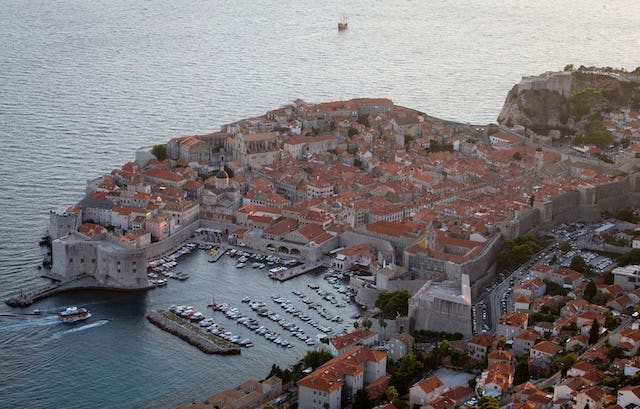 Chris Mooney and Brady Dennis, writing in the Washington Post, illustrate the reality of the flooding threat from rising seas. They open with a description that lays it out in rather stark terms …
Chris Mooney and Brady Dennis, writing in the Washington Post, illustrate the reality of the flooding threat from rising seas. They open with a description that lays it out in rather stark terms …
The old city of Dubrovnik, clinging to the Croatian coast of the Adriatic Sea, is one major storm away from a flood that could cover 10 percent of a medieval city long known as the “Pearl of the Adriatic” and more recently as a main setting for HBO’s “Game of Thrones.”
It’s one of about 40 treasured historical sites across the Mediterranean, including the winding canals of Venice and the ancient city of Carthage, at risk from rising seas, according to a study published Tuesday in the journal Nature Communications.
Let’s pause there and leap directly to the study itself to see what it tells us.
Mediterranean UNESCO World Heritage at risk from coastal flooding and erosion due to sea-level rise
Published in Nature Communications on 16th Oct 2018, the study has a specific focus upon the UNESCO World Heritage sites within the Mediterranean region. They use four potential sea-level rise scenarios that are possible for the period between now and 2100 and look to see how that alters flooding and costal erosion risks.
Today – if no further sea level rise takes place – then ….
of 49 cultural WHS located in low-lying coastal areas of the Mediterranean, 37 are at risk from a 100-year flood and 42 from coastal erosion
… yet rather obviously a world in which sea level is rising leads to greatly increased risks and makes them far more probable.
Why do a study like this?
Their results provide a first-order assessment of where adaptation is most urgently needed. This will support policymakers in steering local-scale research to devise suitable adaptation strategies for each world heritage site.
Those responsible for the management of world heritage sites have had very little to almost no solid information relating to the threats that an increasing sea level rise will bring, so this study addresses this.
Why specifically the Mediterranean?
These are very specifically sites that have a high intangible value, they represent icons of human civilisation. This is where what we term civilisation came from, several ancient cultures developed in the region.
The term used is that these are all sites that have “Outstanding Universal Value”.
Which sites exactly are in focus here?
Below are the UNESCO cultural World Heritage sites located in the Mediterranean Low Elevation Coastal Zone (LECZ). All sites are shown with their official UNESCO ID and name. The map also shows extreme sea levels per coastal segment based on the Mediterranean Coastal Database under the high-end sea-level rise scenario in 2100
What is going to happen?
The magnitude of the risk largely depends on what we do over the next decade or two.
If the goals of the Paris Agreement are not met, the amount of sea level rise will exceed the height of a 100-year storm surge by a factor of 1.4 under RCP8.5, and a factor of 3 under the high end scenario in 2100. Therefore, sea level rise will become a far larger threat to World Heritage Sites than the present-day 100-year storm surge risk. Beyond this immediate study another recent study of future extreme sea levels at the European scale has come up with similar results, suggesting that present-day 100-year events in the Mediterranean will occur much more frequently, up to several times per year, by 2100.
The study results illustrate the value of rigorous global-scale mitigation efforts which could be crucial in preventing World Heritage Sites from losing their Outstanding Universal Value, especially as protection measures only work effectively up to a certain water level.
Beyond the year 2100, we face a longer term risk of even higher sea level, therefore adaptation planning will need to prepare for those scenarios.
Bottom line: Our history is being threatened by climate change. Once gone it can never be retrieved.
Comments
Lena Reimann, a researcher at Kiel University in Germany and a lead author of the study …
“What surprised me the most is that actually even under current conditions, there are so many World Heritage sites that are at risk,”
“…We cannot put a value on what we will lose … It’s our heritage — things that are signs of our civilization. It cannot really be put in numbers. It’s more an ethical question, a moral question. We will not be able to replace them once they are lost.”
Tweets
It's not just Venice who could be doomed under sea level rise. The Mediterranean could swamp Carthage, Dubrovnik, Ravenna, Aquileia and nearly three dozen other @UNESCO World Heritage sites, per a new study: https://t.co/MW8crdtte1 Via @chriscmooney @brady_dennis
— Juliet Eilperin (@eilperin) October 16, 2018
A study says that some of the most important ancient sites in the Mediterranean might not survive the era of climate change. Here is our series on other heritage sites — from the Cedars of Lebanon to the statues of Easter Island — that are also at stake. https://t.co/lbUpGGvsRK
— The New York Times (@nytimes) October 16, 2018
These World Heritage sites could be damaged or destroyed by climate change https://t.co/vh8UOU51hj pic.twitter.com/Vfkx16AMbV
— CNN International (@cnni) October 16, 2018
Under current conditions, researchers found that out of the 49 UNESCO heritage sites across the Mediterranean that were surveyed, more than 90 percent of these sites are at risk. https://t.co/HNG1bsnq4t
— Atlas Obscura (@atlasobscura) October 16, 2018
Mapped: The Mediterranean world heritage sites at risk from sea level rise | @daisydunnesci @kieluni @CUNY https://t.co/HE4Okgokz7 pic.twitter.com/yBgSSHco2Z
— Carbon Brief (@CarbonBrief) October 17, 2018

